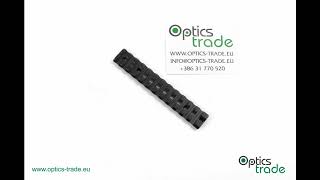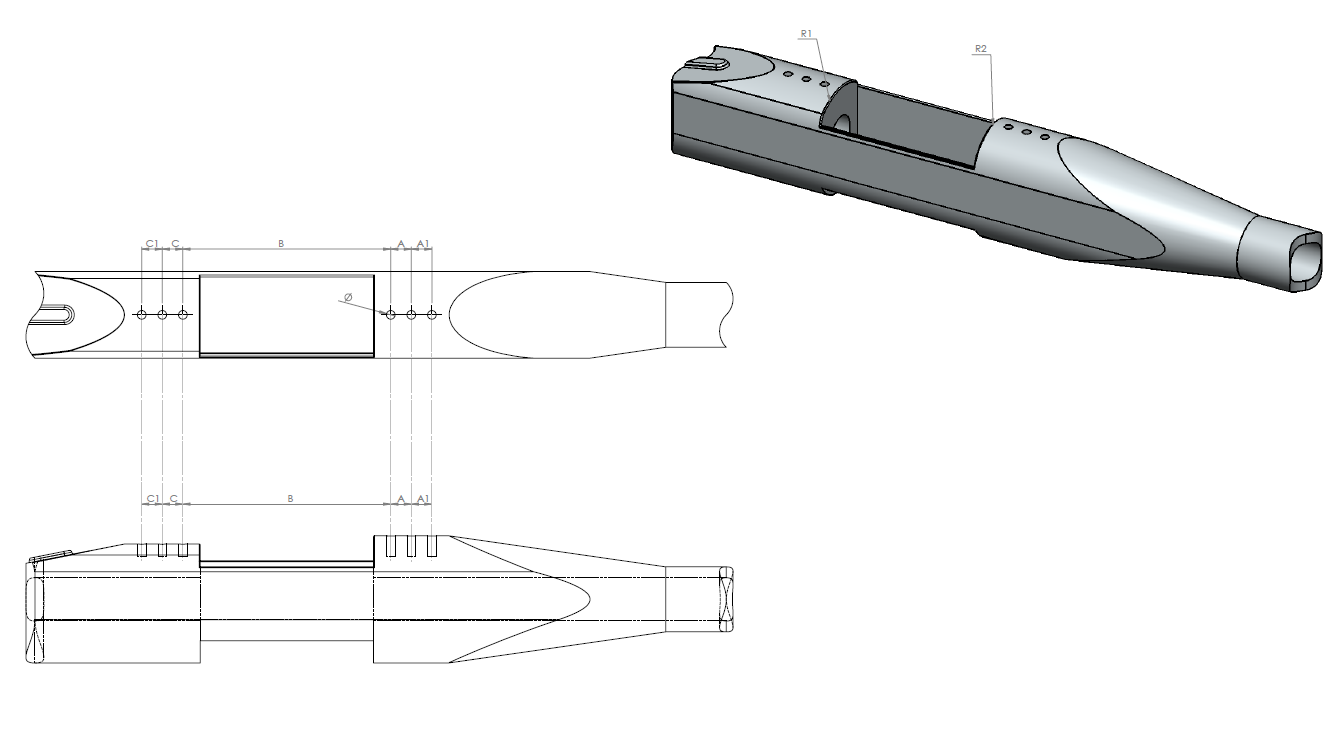Mounts
EAW Steel Picatinny, Steyr SBS 96, B: 69 mm
Reviews & Testimonials
No reviews
Do you have any experience with this product?
We would love to hear your opinion by rating it:
We would love to hear your opinion by rating it:
Community uploads
Upload photo/video
Most common questions (Q&A)
Need help? Not sure about something? Don't hesitate - ask our community! Our experienced community is here to help you with this question.
Ask question
Subscribe
In stock
EAW Steel Picatinny, Steyr SBS 96, B: 69 mm
$129.00
EAW Steel Picatinny, Steyr SBS 96, B: 69 mm Product description
Introduction
Picatinny rail consists of slots with 5.23 mm spaces between one another, which means that it can be used across its entire length. It is simple to mount and interchangeable – if something is made for a Picatinny rail, it will fit regardless of the manufacturer or manufacturing date. It is affordable, resilient and reliable – this is why it so commonly used by professionals and military. Because of all its great qualities, Picatinny rail has been dominating the rail market in the recent years.
Picatinny is a big step forward from the Weaver standard. Weaver has a few predesignated slots while Picatinny has slots all over its surface, allowing the device to be mounted wherever the user finds it fitting. Weaver's slot is 3.8 mm wide, which is why ring mounts made for a Weaver rail will also fit on a Picatinny rail while ring mounts made specifically for a Picatinny rail will not fit on a Weaver rail. This is one of the main reasons why Picatinny is a far better mounting solution.
EAW is a German company, known for producing top-quality mounts. Their Picatinny rails, which are all made from steel, have a nice finish and come with a unique channel in the middle, allowing the user to clearly see the rifle's sights. Screws are included. EAW chooses only the best materials for their products. All of these great features; however, come at quite a steep price.
About the rifle
Steyr Mannlicher, a renowned company that produces firearms, was founded in 1864 by Josef Werndl. It soon grew into a big company with great production capacity. In 1882, they faced a small crisis because of lack of large orders (they had supplied the European armies with breech-loading rifles – demand declined). This is when Werndl used the company's production capacity to manufacture all sorts of products along with firearms: dynamos, electric motors, light bulbs, bicycles, cars, trucks. The company's most active years were without a doubt during World War I when more than 4000 firearms were made daily by its 15.000 employees. The company's name was changed to Steyr-Daimler-Puch AG in 1987.
It is important to know that SBS is not a rifle by itself, but an action (SBS stands for Safe Bolt System) which can be found in many different models of Steyr: Classic, CL II, SM 12, Pro Hunter, Pro Alaskan, Jagdmatch, Scout etc. SBS is a concept that deviates from the established principle of locking lugs at the rear of the bolt. Instead, two opposing lugs are formed at the front of the bolt. The safety catch has three positions: in the first position, the firearm is ready to fire and a red dot can be seen on the safety catch; in the second position, the user can see a white dot on the safety catch – the trigger is locked but the bolt can still be operated (loading, unloading); in the third position, where a white stripe and a white dot can be seen on the safety catch, both the trigger and the bolt are locked.
There is a difference between older (without SBS) and newer Steyr rifles (with SBS) as regards radiuses on the receiver (where holes are drilled for mounting purposes). The newer models are flatter (R35) than older models (R17.5, R15).
Steyr Mannlicher SM 12 is a bolt-action rifle that features Steyr's SBS (Safe Bolt System). There are two locking lugs on each side of the bolt, 4 lugs altogether. The action operates very smoothly. Its bolt operates on a 90-degree lift and has a Sako-like extractor with a pivoting claw at the head (push-feed). It also features two emergency gas ports. SM 12 is equipped with Steyr's Hand Cocking System which allows the user to manually cock the internal firing mechanism, which increases safety since it allows manual decocking of the firing pin. To load the firing pin and deactivate the safety, the user has to press it forward. To release it and engage safety by decompressing the spring, the user has to push it downward. The mechanism is very easy to operate and does not confuse the user, unlike some others. SM 12's barrel is chambered for .243 Win., .308 Win., 7mm-08 Rem., 7x64, .270 Win., .30-06 Sprg., .25-06 Rem., 6.5x55 SE, 8x57 JS and 9.3x62. The magnum versions are chambered for 7mm Rem. Mag., .300 Win. Mag., .300 Wby., 8x68 S, .270 WSM and .300 WSM. Magazine capacity is 4 rounds. There are 6 holes drilled on the receiver for mounting purposes – 3 at the front and 3 at the rear.
Steyr Mannlicher CL II, Steyr's 21st-century bolt-action rifle, features SBS (Safe Bolt System). It is a successor to the famous Steyr Mannlicher Classic series. There are 4 locking lugs on the bolt, 2 on each side. The action is push-feed. Magazine capacity is 4 rounds. Standard models' barrels are 560 mm long while magnum models are equipped with 620 mm long barrels. There is also a possibility of choosing Mountain, Light or Semi-weight model, which have 508 mm long barrels. Steyr chambers CL II for the following calibers: .222 Rem., .223 Rem., .243 Win., .308 Win., 7mm-08 Rem., .270 Win., 7x64, .30-06 Sprg., .25-06 Rem., 6.5x55 SE, 8x57 JS, 9.3x62, .300 Win. Mag., 7mm Rem. Mag., 8x68 S, .270 WSM, .300 WSM., .300 Wby Mag., .375 H&H and .458 Win. Mag. CL II submodels are CL II Halfstock, CL II Halfstock Stainless, CL II Mountain, CL II Light, CL II Semi-weight and Jagdmatch. All of these except Jagdmatch are also available in SX-versions. These feature robust SX-stock with rubber inlays and prismatic aluminum bedding.
Steyr Classic with SBS (Safe Bolt System) was introduced in 1997 and replaced Steyr Mannlicher models from 1969. The rifle is available in full-stock and half stock-version. Full-stock version is chambered for .243 Win., .25-06 Rem., 6.5x55 SE, .270 Win., 7mm-08 Rem., 7x64 mm, .308 Win., .30-06 Sprg. and 8x57 JS. The half-stock version was made for .25-06 Rem., .243 Win., 6.5x55 SE, .270 Win., 7x64 mm, 7mm-08 Rem., 7mm Rem. Mag., .300 Win. Mag., .308 Win., .30-06 Sprg., 8x57 JS, 8x68S and 9.3x62 mm.
Pro Hunter was first introduced in 1997 and features SBS (Safe Bolt System). The SBS safety catch is same as on Classic. There are two variants to choose from Stainless and Mountain. Both are chambered for. .243 Win., .25-06 Rem., 6.5x55 SE, .270 Win., 7 mm-08 Rem., 7x64 mm, 7 mm Rem. Mag., .300 Win. Mag., .308 Win., .30-06 Sprg., 8x57 JS, 8x68S and 9.3x62 mm. The Stainless version comes without sights. Mountain version is 101 cm long and weighs 2.85 kg while the Stainless version is 108 cm long and weighs 2.95 kg. There are altogether 6 holes drilled and tapped on the receiver (3 at the front and 3 at the rear) – for mounting purposes.
Scout, introduced in 1998, also features SBS (Safe Bolt System). It comes with a bipod (the two legs form a part of the stock) and has a flat top (there is Weaver rail on top). Steyr only produced Scout in two calibers: .223 Rem. and .308 Win. Its magazine holds five cartridges.
A1: 11.84 mm
A: 10 mm
B: 69 mm
C: 11.84 mm
C1: 10 mm
BHU: 0 mm
Fi: 6-48
R1: R35
R2: R35
On our webpage, we have divided the mounts for Steyr rifles as follows:
If the radius of both mounting surfaces is R17.5 or R15, it means that the mount is designed for an older Steyr rifle without SBS – these are gathered on our webpage under the categories Steyr Mannlicher SL, Steyr Mannlicher L, Steyr Mannlicher M and Steyr Mannlicher S. Distance between inner mounting holes on the receiver is provided (B distance – see the image above):
- Steyr Mannlicher SL (super light) – chambered for .222 Rem., .222 Rem. Mag., .223 Rem. and 5.6x50 Mag.
- Steyr Mannlicher L (light) – chambered for 5.6x57, .243 Win., .308 Win., .22-250 Rem., and 6mm Rem.
- Steyr Mannlicher M (medium) – chambered for 6.5x57, .270 Win., 7x57, 7x64, .30-06 Sprg., 8x57 and 9.3x62, 6.5x55 and 7.5x55.
- Steyr Mannlicher S (heavy/magnum) – chambered for 6.5x68, 7mm Rem. Mag., .300 Win. Mag., 8x68 S, .375 H&H, .338 Win. Mag., .300 H&H Mag. and 9.3x64
If the radius of both mounting surfaces is R35, it means that the mount is designed for Steyr SBS. We have also added a distance between the inner mounting holes on the receiver (B distance – see the image above):
- Steyr SBS B: 69 mm
- Steyr SBS B: 56 mm
- Steyr SBS B: 62 mm
- Steyr SBS B: 73.5 mm
- Steyr SBS B: 76 mm
- Steyr SBS B: 83 mm
- Steyr SBS B: 87.5 mm
- Steyr SBS B: 100.2 mm
- Steyr SBS B: 104.7 mm
This mount is suitable for Steyr SBS with B distance of 69 mm.
Steyr rifles with SBS system have 6 mounting holes on the receiver (3 at the front and 3 at the rear). To choose an appropriate mount, you have to measure the distance between the inner holes (holes 3 and 4 – check the image above, distance B).
Mounting instructions
Remove all the stains (grease, oil etc.) from the rifle's receiver with a cleaning fluid (acetone). Once the surface is clean and dry, check whether the screws match the rail and the holes on the receiver. Make sure that the Picatinny rail is compatible with the rifle by inspecting the mounting holes on both. Before mounting the rail permanently, apply a minimal amount of thread-locking fluid 278 or 648 on screws and contact surfaces. Be careful not to get the fluid in or near the mounting holes. Carefully clean the remaining excess fluid around the rail with a cleaning fluid. Using a torque driver, screw the screws appropriately (up to 2.2 Nm) – do not overtighten.
Warranty
The product has a warranty period of 30 years.
General properties
| Mount series | EAW Picatinny Rails |
|---|---|
| Made in | Germany |
| Warranty | 30 years |
Physical properties
| Length. | $126.00 |
|---|---|
| Material | Steel |
| BH-build height. | $7.00 |
| Inclination | 0 MOA |
| Type of Base | Picatinny |
| Scope - Sight type | Picatinny Rail |
| A | 21.84 mm |
| B | 69 mm |
| C | 21.84 mm |
Characteristics
Shipping Assistant
Choose your delivery destination & delivery service
Your location will be kept while looking for other products.
You can pay with all popular payment methods.
Changing Location
Info
Looking for useful documents or social groups about this product? Here they are:
Reviews
Would you like to see this product in action? Watch different videos:
Social
Want to know what others think of this? Check out these posts from social networks.































